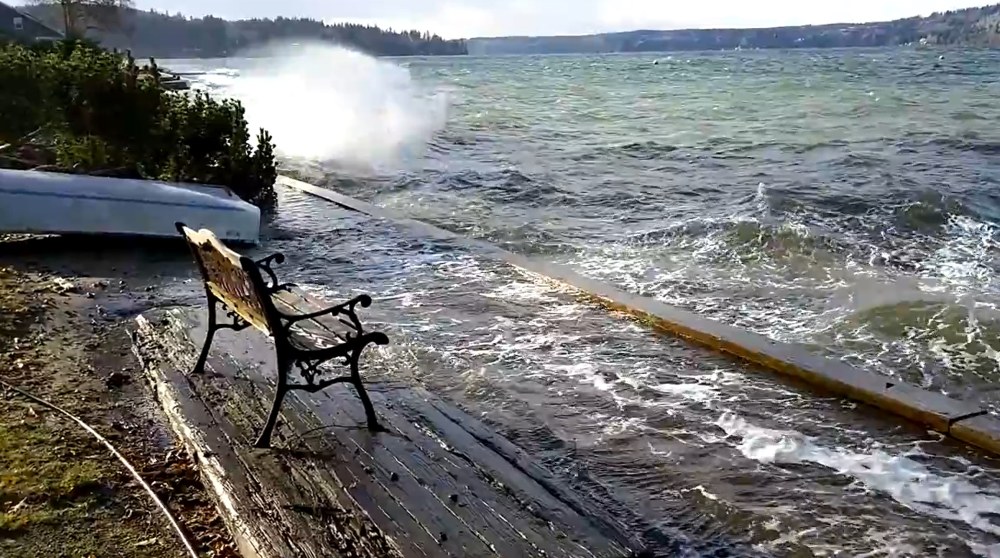At 7 am Christmas morning, when most of us will be focused on tinsel and eggnog, Puget Sound will fill to capacity — its highest level in a year.
The sound will bulge to more than 1,000 square miles. Beaches will all but disappear. Waves on Elliott Bay may slosh onto piers and ferry ramps will flatten. High water will refloat thousands of beach logs, posing navigational hazards until they’re washed up on another beach miles away. In my community near Port Townsend, the high water may test the costly new berm built to keep the ocean out of our beachfront clubhouse.
Barring high winds (and they are not forecast), there shouldn’t be any damage. But it will be visually and statistically impressive. Seattle’s sea level will rise some 17 feet in a few hours, sucking billions of gallons of Pacific seawater into the sound, then back out again. The tidal change will range from 14 feet in Port Townsend to a whopping 20 feet in Olympia.
This event will have nothing to do with climate change or rising sea levels. These are king tides, an annual phenomenon caused by gravity, Earth’s elliptical shape and its December alignment with the sun and moon.
However, it is also an opportunity to ponder the prospects of climate change. Earlier this month, the Seattle Times waded in with a Sunday story on plans to move the Quinault Indian Nation’s coastal village to higher ground in anticipation of rising sea levels and worsening storms caused by climate change.
The article got plenty of attention, including a detailed critique by Cliff Mass, the University of Washington meteorologist known locally for his terrific radio voice, his book on Northwest weather, and his popular blog. The Times report was “just plain wrong,” he blogged. “Clear factual errors.” He supported his argument with data that indicate there is no evidence of a long-term trend in Northwest winds nor storms.
And sea levels? “Yes,” he writes. “The ocean water levels are going up slowly as the earth warms up. But if the land rises, the actual water level on the coast can stay the same or go down.”
And there is ample evidence that the Northwest coast is uplifting.
Rising sea levels are a huge matter of concern in much of the world – from Florida to Bangladesh and the South Pacific.
But the Pacific Northwest may have less to worry about – at least in the short term. A 2017 NOAA report included a map of long term sea level projections. Coastal areas from North Carolina and Miami to Galveston and San Diego were coded red – at risk of serious sea level increases later in this century. But coastal regions of Alaska and the Pacific Northwest are at much lower risk.
Why? As Mass points out, our meteorology is linked to geography. The last Ice Age squished the region under thousands of feet of ice, which compressed the Earth’s crust. As the ice retreated, the land began to decompress.
“And it’s still rebounding,” Mass wrote.
Don’t try to watch, because it’s measured in millimeters, or fractions thereof. But so is sea level increase, and the two tend to offset.
Regional tectonics are another factor, Mass says. “As the Juan de Fuca tectonic plate is pushed downward, coastal land is elevated.” That famous rift off our coast poses the threat of earthquakes, potentially the Big One. But, when it comes to sea levels, it may work to our advantage.
These changes are measured in millimeters over decades of time. How many millimeters? The NOAA report projected that sea level increase in the PNW would be less than the global average. Estimates range from a tenth of a meter to a meter by 2100.
A tenth of a meter over 80 years would not pose many problems. A meter would be a huge challenge. That’s why Seattle has been beefing up its waterfront and why the Quinaults want to move to higher ground.
But this weekend’s king tides, and another round of similar tides January 21-25, might leave us wishing the consequences of global warming were so predictable. Tide changes closer to the equator are minimal – three feet in Florida. But here on Puget Sound, sea levels fluctuate every day, sloshing in and out, moving massive volumes of seawater, constantly changing and changed by geography, and making our lives more interesting.
Discover more from Post Alley
Subscribe to get the latest posts sent to your email.

Liked your “typing in Port Townsend” best. Greetings from Lake Stevens. Dryland projected. Hi to Mary and Leslie.